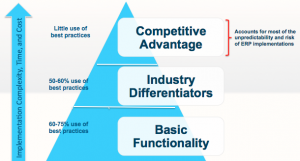ERP
The Real Reasons Why ERP Implementations Fail to Deliver to Expectations

CFOs and CIOs of most organizations begin their ERP implementations with the expectations that their businesses will be transformed along the way. Using the power and flexibility of ERP systems such as SAP, Oracle, Microsoft Dynamics and Tier II ERP software, executives expect material cost improvements to their supply chains, more effective interactions with their customers, and better visibility to operational information. However, as outlined in our 2012 ERP Report, 50-percent of organizations fail to realize even half of their expected business benefits.
Based on this gap between expectations and delivered reality, it is clear that something gets lost in translation from the time the executive team signs off on the investment until the organization flips the switch on its new ERP software. Unfortunately, the things that seemed feasible at the outset of most enterprise software initiatives seem unattainable as those same initiatives progress.
There are a handful of challenges we see every day with our clients – both the ones that enlist our assistance with implementation and those that retain our services for expert witness engagements related to their ERP failures. Here are three common pitfalls that most organizations have trouble navigating:
-
- Tradeoff between speed, cost and business results. Most CFOs and CIOs are painfully aware of the risks associated with ERP implementations, and most are even more aware that a botched deployment will likely cost them their jobs. While there is a need to leverage enterprise software as an enabler of business transformation on the one hand, there is the pressure to deliver on time and on budget on the other. These competing priorities are inherently in conflict and, when forced to choose, speed and cost will almost always trump business results. After all, leaders within most organizations know they won’t be around to see the business transformations come to fruition if they don’t survive the ERP implementation. Further, the risk-adverse nature so common to executives often lead them to choose this safer route without ever directing necessary organizational focus to potential business improvements.
- Unrealistic expectations. Most executives have unrealistic expectations to begin with. They too often hear (and believe) the sales hype from ERP vendorsthat their software can be implemented in relatively little time, cost, and risk. For example, while our experience and research shows that the average implementation takes 14 months and significantly longer for larger and multi-national companies, it is not uncommon for software sales reps to suggest that their software can be implemented in just several months. These unrealistic expectations result in unrealistic budgets and resource allocations, causing corners being cut when it becomes clear that there are inadequate resources to get the job done. When executive and project teams are under the gun to finish the project anywhere close to original projections, you can be sure that post-implementation business results are one of the first things to get thrown by the wayside.
- “Best practices” = watered down competitive advantage. Just as point #1 creates competing priorities, so do the concepts of software “best practices” and quantum leaps in competitive advantage. In other words, if a certain business process is baked into an ERP software’s canned best practices, chances are that it’s not always going to result in a material improvement to operations. Sure, more transactional, back-office operations like accounts payable or HR compliance may see a lift, but your core customer-facing processes and competitive advantages are much less likely to benefit from these so-called best practice, off-the-shelf functionality. As a result, and as outlined in the below graphic, organizations too often end up with watered down competitive advantages or business processes that simply mimic or automate their old way of doing business.

There is no easy answer to how to best achieve business results that meet or exceed executive expectations and lead to true business transformations. However, there are a number of proven success factors that can help ensure your ERP implementation leads to material business improvements, such as:
-
-
- Ensure a realistic implementation plan that outlines the true resource requirements of a successful implementation
- Clearly define the goals and priorities of the ERP implementation – for some it will be to get the job done on time and on budget with little to no focus on measurable business results, but for most it will be to deliver a marked improvement to business operations
- Quantify and prioritize expected business results, which will drive various aspects of the initiative
- Let business processes drive the entire initiative, from ERP software selection all the way through the multiple phases of implementation and post-implementation
- Focus on organizational change management to ensure potential business process and system improvements “stick” within the organization
-
These success factors will ensure that your ERP implementation delivers the results expected by your organization.
[This post originally appeared on Panorama Consulting’s 360 ERP blog and is republished with permission.]






